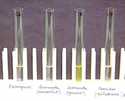CDC’s Research Contributions
Over the past three decades, CDC has contributed to the world’s knowledge of malaria, especially the burden of malaria in areas of high malaria transmission in children and pregnant women and the impact of drug resistance. CDC has contributed to the development and evaluation of prevention and control interventions recommended by the World Health Organization and used by programs worldwide to fight malaria: insecticide-treated bed nets (ITNs), intermittent preventive treatment in pregnancy (IPTp), and artemisinin-based combination therapies (ACTs).
Having completed the research that has informed the current generation of malaria control interventions, CDC is well-positioned to refine malaria interventions as well as develop new interventions to stay ahead of the curve—and contribute to achieving the ambitious global goals of malaria elimination and ultimately eradication.
CDC’s Research Highlights
In the last decades, CDC has contributed to our knowledge and understanding of these areas:
- Understanding the impact of malaria
- Monitoring drug resistance
- Developing and evaluating interventions
- Antimalarial drug use, diagnosis, and non-falciparum malarias
- Malaria in travelers
Understanding the impact of malaria
-
CDC work in Malawi and Kenya established the role of malaria in infant and early childhood mortality in high transmission settings and documented the public health importance of severe malaria-related anemia as a major cause of death in such populations.
-
CDC studies in Malawi and Kenya determined the risk of malaria-associated low birth weight, one of the adverse effects of malaria infection during pregnancy.
-
CDC has also made substantial contributions to efforts to quantify the burden of malaria mortality in African children and the burden of malaria in pregnancy.
Toolkit Helps Assess the Burden of Malaria during Pregnancy
 CDC, WHO, and other partners developed a toolkit to help assess the burden of malaria during pregnancy in countries without recent data. Safe and effective interventions can help prevent adverse consequences of malaria in pregnancy.
CDC, WHO, and other partners developed a toolkit to help assess the burden of malaria during pregnancy in countries without recent data. Safe and effective interventions can help prevent adverse consequences of malaria in pregnancy.
Monitoring drug resistance
Beginning in the late 1950s, resistance to the most commonly used antimalarial drug, chloroquine, began to appear almost simultaneously in Southeast Asia and South America.
-
Starting in the 1980s, CDC called attention to the impact of antimalarial drug resistance in Africa. CDC and colleagues documented the public health impact of chloroquine resistance and helped countries in sub-Saharan Africa establish malaria drug resistance monitoring networks.
-
In the early to mid-1990s, CDC and WHO developed and implemented standard protocols for assessing the therapeutic efficacy of drugs and changing antimalarial drug treatment guidelines. CDC helped develop standard techniques that use molecular techniques for discerning reinfection from recrudescence to assess drug efficacy outcomes in high transmission settings.
-
As a result of the findings from CDC-assisted drug efficacy testing, first-line antimalarial drug policy changed from chloroquine to sulfadoxine-pyrimethamine (SP) in Malawi, Zambia, Kenya, Tanzania, and the Democratic Republic of Congo. CDC contributed to economic evaluations of the costs associated with changing antimalarial drug policies.
-
CDC continued to contribute to the knowledge of drug resistance by determining the origin and distribution of SP-resistance alleles across Africa. CDC and KEMRI documented the SP "killer" gene mutation 164 in Africa, which signaled the end of the useful lifetime for this class of malaria treatment drugs.
Developing and evaluating interventions
CDC conducted groundbreaking work to develop and evaluate IPTp, to evaluate ITNs in areas of high malaria transmission, and to define how best to manage malaria cases in children. CDC is also working on evaluating new technologies for malaria control.
Intermittent Preventive Treatment for Pregnant Women (IPTp)
-
CDC determined that intermittent preventive treatment of malaria during pregnancy (IPTp)—the delivery of curative doses of effective antimalarial drugs as part of routine prenatal care—reduced the risk that malaria-infected pregnant women would have babies with low birth weight, a contributing factor to infant death.
-
To benefit from treatment, pregnant women who are HIV-positive need more doses of IPTp with the drug sulfadoxine-pyrimethamine (SP) or, in some cases, a different drug.
Insecticide-treated Bed Nets (ITNs)
-
CDC and the Kenya Medical Research Institute (KEMRI) completed one of the first studies to demonstrate that ITNs could reduce malaria-related illness and death in an area of very intense, year-round malaria transmission. Prior to these findings, all of the evidence of bed net efficacy in Africa had been collected in settings where transmission was only moderate or exclusively seasonal.
-
This study also broke ground by showing that if enough people in a malaria-endemic community were protected with ITNs, the absolute numbers of mosquitoes would be reduced and even individuals in neighboring households without ITNs could be protected from infection (the "community effect").
-
CDC studies also allayed concerns that continued use of bed nets would simply cause children at risk of malaria-related death to die at slightly older ages. Use of regularly maintained ITNs for an additional 2 - 4 years showed that continued protection for infants did not shift mortality to older children.
-
Pregnant women also were shown to benefit from ITNs. When pregnant women slept under ITNs, malaria infections and the malaria-associated ill effects in pregnancy were reduced. In addition, severe malarial anemia was reduced by 47% and the delivery of low-birth-weight infants decreased by 28%.
CDC’s "X-Ray Gun" Measures Insecticide on Nets
 A CDC scientist has adapted an x-ray fluorescence analyzer to quickly measure the level of the insecticide deltamethrin on insecticide-treated bed nets (ITNs).
A CDC scientist has adapted an x-ray fluorescence analyzer to quickly measure the level of the insecticide deltamethrin on insecticide-treated bed nets (ITNs).
Use of Both ITNs and Indoor Residual Spraying
-
In a 2008–2009 study in Rachuonyo District, Kenya, CDC determined that the use of both ITNs and IRS reduced malaria infections by 62% (and by 67% among those 6 months to 4 years, the most vulnerable) compared with use of ITNs alone. IRS also reduced the numbers of anopheline mosquitoes. These data suggest for the first time that by using both interventions together, people living in areas that receive both interventions benefit considerably.
Case Management
-
Most of the deaths caused by malaria are in young children under 5 years of age. CDC helped establish the clinical basis for the Integrated Management of Childhood Illnesses (IMCI) strategy and assessed components of its implementation. IMCI is an approach developed by WHO and the United Nations Children's Fund (UNICEF) that promotes accurate identification of childhood illnesses in outpatient settings, ensures appropriate combined treatment of all major illnesses, strengthens caretaker counseling, and speeds referral of severely ill children.
-
After resistance developed to sulfadoxine-pyrimethamine, which had replaced chloroquine for first-line treatment, artemesinin-containing combination therapies (ACTs) were widely adopted; CDC contributed to establishing valid techniques for measuring adherence to ACTs.
Intermittent Preventive Treatment of Infants (IPTi)
-
CDC contributed to understanding the role of intermittent preventive treatment of infants (IPTi) in reducing malaria illness. Similar to IPTp, IPTi consists of treatment doses of sulfadoxine-pyrimethamine (SP), delivered to children regardless of malaria infection or symptoms at their first 3 routine vaccinations. Studies have demonstrated that IPTi can reduce the incidence of clinical malaria by a little more than 30%.
Antimalarial drug use, diagnosis, and non-falciparum malarias
Antimalarial Drug Issues
In many countries substandard and counterfeit drugs present a problem.
-
CDC-developed a colorimetric test for counterfeit artesunates, an important ACT. The test can be used by workers in the field to determine whether the packaged drug contains the antimalaria drugs.
-
CDC and Ifakara Health Institute completed the only study of malaria infection among clients at retail shops and contributed to the first nationally representative study of antimalarial drug quality in the retail sector.
-
CDC contributed to testing new drug candidates and vaccine components in nonhuman primates.
CDC’s Dye Test Detects Counterfeit Antimalarials

A colorimetric test developed at CDC to assess the quality of artesunate requires only a small portion of an artesunate tablet (1%). After the material is exposed to a strong base and then treated with a reagent, a distinct yellow color is produced if artesunate is present.
Diagnosis
-
CDC collaborated with local research institutions in Kenya and Tanzania to learn more about how best to use recently available rapid diagnostic tests (RDTs) for malaria, which can provide diagnosis in as little as 15 minutes.
-
Recent CDC supported research in Tanzania demonstrated that health workers at rural health facilities can successfully use RDTs to improve patient care when supported by appropriate supervision and RDT quality control. In response to these studies, the Tanzanian National Malaria Control Program is exploring options for providing adequate supervision and quality control to deliver malaria RDTs nationwide. Better diagnostics and appropriate treatment will result in fewer malaria-related complications and deaths and provide a more accurate way of measuring the impact of malaria control.
-
Recent CDC-supported research on RDTs in Kenya showed that these tests were underutilized, but when they were used, the results were followed properly by health workers.
-
-
CDC helped demonstrate that many malaria parasites in South America do not produce a specific protein product, which will preclude the use of many RDTs for malaria in endemic regions on this continent.
Non-Falciparum Malarias
-
CDC contributed to the understanding that P. vivax, long thought to be much less lethal than P. falciparum, could be quite virulent.
-
CDC helped document that a 5th malaria parasite, P. knowlesi, which was recently recognized as a cause of human malaria disease, had been imported into North America by a traveler.
Malaria in travelers
-
CDC contributes to research of malaria in U.S. citizens who acquire malaria elsewhere by establishing rates of failure and adverse reactions for U.S. travelers and Peace Corps volunteers taking chloroquine, sulfadoxine-pyrimethamine, and mefloquine for malaria prevention.
- Page last reviewed: October 19, 2015
- Page last updated: October 19, 2015
- Content source:


 ShareCompartir
ShareCompartir